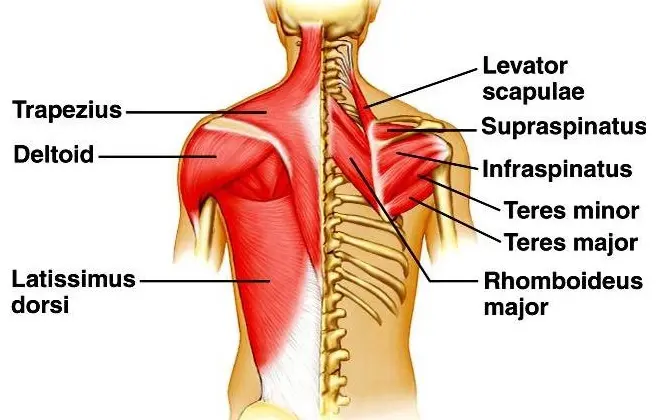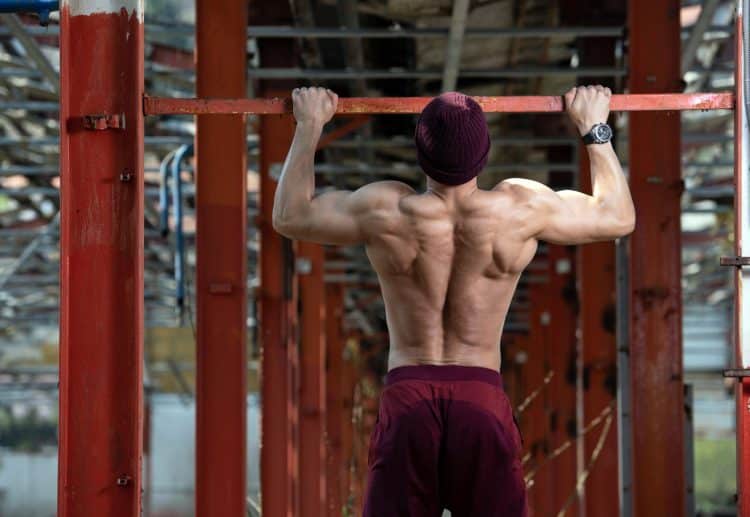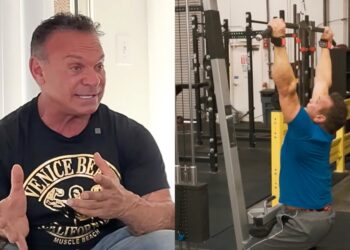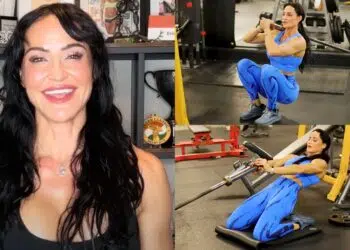There is a saying in the fitness industry: If you always do what you’ve always done, you’ll always get what you always got. In simple terms, this means that if you want to change your body, you need to periodically change your workouts. Doing the same thing over and over will invariably produce the same results.
Unfortunately, many lifters get stuck in a rut and stick with the same program long past its sell-by date. As a result, their muscles stop growing, and they find themselves teetering on the edge of a progress plateau.
This reluctance to change programs often comes from fear of the unknown or the hope that a once-productive workout will start working again.
If your current workout routine has stopped working, small changes won’t bust you out of your progress prison. Instead, you need to make dramatic changes to your training regimen and get your training back on track. One way to do this is with supersets.
In this article, we share our latest back superset workout designed to pack on mass and build strength in double-quick time.
Back Anatomy Basics

When the average person talks about their back, they’re usually referring to their lumbar spine or lower back. This makes sense, given that this is a problem area for a lot of people and a common source of discomfort and pain. A high percentage of adults experience back pain in their lifetimes, and it’s a leading cause of work absenteeism and disability.
Level Up Your Fitness: Join our 💪 strong community in Fitness Volt Newsletter. Get daily inspiration, expert-backed workouts, nutrition tips, the latest in strength sports, and the support you need to reach your goals. Subscribe for free!
In contrast, when bodybuilders talk about their backs, they’re referring to several muscles that make up the rear of their torsos. When well-developed, the back muscles give your upper body thickness and width, making you look powerful and strong.
While some bodybuilders neglect their backs and focus more on the muscles they can see in the mirror, lifters in the know pay as much attention to the muscles on the back of their bodies as the front. A big, muscular back is a beautiful sight to behold!
The main muscles that make up the back are:
Latissimus dorsi
The latissimus dorsi, or lats for short, are located on the sides of your torso. When well-developed, they resemble broad, muscular wings. These muscles play a crucial role in most shoulder joint movements, including extension, adduction, and medial rotation.
Trapezius
The trapezius or traps is a large, diamond-shaped muscle covering most of your upper back. It comprises three sets of fibers – upper, middle, and lower. The upper fibers elevate your shoulder girdle, the middle fibers handle retraction, and the lower fibers pull your shoulders down in a movement called depression.
Rhomboids
Working alongside the mid-traps, the rhomboids play a crucial role in pulling your shoulder blades back and together, which is a movement known as retraction. Though relatively small, they contribute to the thickness of your upper back.
Erector spinae
The erector spinae muscles, situated along your spine, play a vital role in maintaining proper posture and supporting your back. There are three erector spinae muscles: the iliocostalis, longissimus, and spinalis. Together, they resemble thick columns running on either side of your spine.
These muscles are involved in several movements, including extension, lateral flexion, and rotation of the spine. During back exercises such as deadlifts and rows, the erector spinae muscles provide the support needed to keep your spine correctly aligned, reducing your risk of injury.
Biceps brachii
It’s hard to train your back without using your biceps brachii, or biceps for short. Located on the front of your upper arms, the biceps flex your elbows. As such, almost all back exercises also train your biceps.
Deltoids
The deltoids are your most significant shoulder muscles. Like the trapezius, they comprise three sets of fibers – anterior (front), medial (middle), and posterior (rear). All three groups of fibers are involved in most back exercises. However, the posterior deltoids are the most active, especially during rowing movements.
Forearms
Forearm and grip strength can make or break your back workout. Most back exercises involve pulling, so you cannot avoid using your forearms. Some exercisers use lifting straps to make up for their weak grip. However, direct grip training may be a better solution than relying on external crutches.
What Are Supersets?
Before we share our latest back workout, let’s take a quick look at supersets, explaining what they are and why they’re so beneficial and effective. That way, you’ll not only know how to perform the workout but also how and why it works.
Supersets involve doing two exercises back-to-back. In other words, you do the first exercise and then, without resting, immediately do the second. On completing exercise number two, you rest for a moment or two and repeat the pairing as many times as required.
For example:
- Pull-ups x 8-12
- Dips x 8-12
- Rest for 1-2 minutes and repeat
Types of Superset
There are several recognized types of supersets, including:
- Agonist supersets – two exercises for the same muscle group, e.g., squats and leg presses. These are also known as compound sets.
- Agonist/antagonist supersets – two exercises for opposing muscle groups, e.g., biceps curls and triceps pushdowns.
- Agonist/opposing synergist supersets – one exercise for a large muscle group and one for an opposing small muscle group, e.g., shoulder presses and biceps curls.
- Agonist/distant agonist supersets – two exercises for anatomically distant muscle groups, e.g., calf raises and wrist curls.
- Lower body/upper body supersets – one leg exercise followed by one torso or arm exercise, e.g., step-ups and push-ups.
- Post-exhaust supersets – a compound exercise followed by an isolation exercise for the same muscle group, e.g., shoulder presses and cable lateral raises.
Pre-exhaust supersets – an isolation followed by a compound exercise for the same muscle group, e.g., leg curls and Romanian deadlifts.
Superset Benefits
What’s so great about supersets? Let’s take a look at the advantages and benefits of this popular and effective training method:
- Shorter workouts – doing two exercises back-to-back means you half the amount of time you spend resting. Supersets make your workouts more time-efficient.
- A better pump – supersets drive a lot of blood into the area you are training, and you’ll get a great pump as a result. Bodybuilders value a good pump, and it’s often considered an indicator of future muscle growth. Plus, pumped muscles look bigger and feel swole!
- A balanced workout – referring primarily to agonist/antagonist supersets, organizing your exercises into opposing pairs means you automatically train both muscles equally. This ensures they grow at a similar rate, which may help prevent muscle imbalances.
Related: Biceps and Triceps Superset Workout for Huge, Pumped Arms
Superset Drawbacks
While supersets are beneficial and effective, there are a couple of drawbacks to consider, too:
- Lower training weights – doing similar exercises back-to-back will lead to more fatigue than usual. As such, you’ll invariably need to use lighter weights for the second movement. This will affect your strength gains but shouldn’t hurt hypertrophy or muscle building.
- Monopolizing training equipment – doing pairs of exercises means you’ll need to monopolize two sets of equipment, one of which you won’t even be using. This can be a problem in busy gyms, and doing supersets could make you unpopular with your fellow exercisers.
- Cardiovascular fatigue may be an issue – moving quickly from one exercise to another won’t just challenge your muscles; it will affect your heart and lungs, too. Poor cardiovascular fitness could leave you huffing and puffing and unable to do the second exercise to the best of your ability. This is especially true for pairs of large compound exercises.
- A very intense training method – pairing two similar exercises together will push your muscles to failure and beyond. Not just once but many times during your workout. As such, this type of training is only suitable for well-conditioned exercisers with good recovery abilities. It is not ideal for beginners.
Learn more about supersets with our detailed guide.
Back Superset Workout Overview
Now that you know more about back anatomy and how supersets work, it’s time to hit the gym and train!
Do the following workout 1-2 times per week as part of a weekly training split, where you train your remaining body parts on different days.
For example:
| Monday | Tuesday | Wednesday | Thursday | Friday | Saturday | Sunday |
| Chest | Back | Shoulders | Legs | Arms | Rest | Rest |
But, before you lift any weights, make sure you warm up to reduce your risk of injury while improving workout performance. Start with a few minutes of easy cardio followed by dynamic mobility and flexibility exercises for your muscles and joints, focusing on your shoulders, elbows, and lower back.
Related: How to Warm Up for Strength Training
Warmed-up and ready? Then let’s get to work!
| # | Exercise | Sets | Reps | Recovery |
| 1a | Pull-ups | 3 | 6-8 | 2-3 minutes |
| 1b | Yates barbell row | |||
| 2a | Chest-supported dumbbell row | 3 | 8-10 | 90 seconds |
| 2b | Lat pulldowns | |||
| 3a | Straight arm pulldowns | 3 | 12-15 | 60 seconds |
| 3b | Seated cable row | |||
| 4a | Reverse cable flies | 3 | 12-15 | 60 seconds |
| 4b | Face pulls |
Chest and Back Superset Workout – Exercise Instructions
There are two ways to do most exercises – the right way and the wrong way. The right way is safe and effective, while the wrong way is usually more dangerous and less effective, even if it allows you to lift heavier weights. Follow these instructions to ensure you’re doing the exercises in your workout correctly.
Level Up Your Fitness: Join our 💪 strong community in Fitness Volt Newsletter. Get daily inspiration, expert-backed workouts, nutrition tips, the latest in strength sports, and the support you need to reach your goals. Subscribe for free!
1a. Pull-ups
Muscles targeted: Latissimus dorsi, trapezius, rhomboids, deltoids, biceps.
If squats are the king of leg exercises, pull-ups should hold the same title for back exercises. No other movement can build back width and thickness like low-tech pull-ups. They’ll also beef up your arms and strengthen your grip. Plus, if you can’t do pull-ups, it could mean you are a) overweight or b) not strong enough to do this workout!
Steps:
- Hang from an overhead bar with an overhand, slightly wider than shoulder-width grip. Bend your legs so your feet are clear of the floor.
- Without swinging or jerking, bend your arms and pull your chin up and over the bar.
- Descend smoothly and under control, and then repeat.
- Move quickly to the next exercise.
Benefits:
- A highly effective back-building exercise.
- Very accessible as most gyms have at least one pull-up bar.
- A legitimate test and developer of upper body functional fitness and strength.
Tips:
- Use a weighted vest to make this exercise more challenging.
- Chalk your hands to stop them from slipping if necessary.
- Use a resistance band for assistance if you cannot do many reps.
1b. Yates barbell row
Muscles targeted: Latissimus dorsi, trapezius, rhomboids, erector spinae, deltoids, biceps.
The Yates row is named after legendary bodybuilder Dorian “the Shadow” Yates, six-time winner of Mr. Olympia. Yates was famous for his colossal back, which he partly attributed to this variation of the bent-over row. Doing Yates rows after pull-ups will fry your lats and leave them pumped for days!
Steps:
- Hold a barbell with an underhand, hip-width grip. Bend your knees slightly and hinge forward from your hips so your torso is inclined to about 45 degrees.
- Without rounding your lower back, bend your elbows and row the bar into your abdomen.
- Extend your arms and repeat.
Benefits:
- More lower back-friendly than conventional bent-over rows.
- A proven back builder.
- The underhand grip puts your biceps in a stronger position than a standard pronated grip, so you can use more weight or do more reps.
Tips:
- Keep your wrists straight throughout.
- Lead with your elbows to maximize lat engagement.
- Keep your upper arms close to your sides to hit your middle back more.
2a. Chest-supported dumbbell row
Muscles targeted: Latissimus dorsi, trapezius, rhomboids, deltoids, biceps.
Despite being pretty lower back-friendly, your erector spinae muscles will probably feel tired after those heavy Yates rows. Don’t worry; the next pairing is designed to punish your lats and traps while sparing your lower back. In fact, your lower back should feel well-rested after these two movements.
Steps:
- Set the backrest on an exercise bench to around 45 degrees.
- Holding a dumbbell in each hand, lie face down on the bench. Allow the dumbbells to hang down from your shoulders.
- Bend your arms and row the dumbbells up into your sides. Shrug your shoulders down and back.
- Extend your arms and repeat.
- Move quickly to the next exercise.
Benefits:
- An excellent exercise for building upper back thickness.
- A good postural exercise.
- A strict movement that’s almost impossible to cheat.
Tips:
- You can also do this exercise with a barbell.
- Lead with your elbows, and keep your wrists straight throughout.
- Raise the bench on blocks if the dumbbells touch the floor when your arms are straight.
2b. Lat pulldowns
Muscles targeted: Latissimus dorsi, trapezius, rhomboids, deltoids, biceps.
The lat pulldown is not named after the muscles it works but, instead, the plane of motion in which your arms move – the lateral plane. Nonetheless, it’s still an excellent lat exercise that will give you a wider, more muscular upper back. Pulling down from above instead of rowing will hit your muscles from a new angle, engaging different fibers and allowing you to push beyond their usual point of failure.
Steps:
- Attach a long bar to a lat pulldown machine.
- Hold the bar with a wider-than-shoulder-width grip. Sit down on the machine with your thighs under the leg restraints. Lift your chest up and pull your shoulders down and back.
- Bend your arms and pull the bar down to your upper chest.
- Extend your arms and repeat.
Benefits:
- A straightforward yet effective lat exercise.
- Very lower back-friendly.
- Easy to adjust the load to reflect your current strength and fatigue.
Tips:
- Lean back slightly to increase upper back engagement.
- Drive your elbows down and back to fully engage your lats.
- Use lifting straps if your forearms and grip are failing.
3a. Straight arm pulldowns
Muscles targeted: Latissimus dorsi, triceps (long head), core.
Your next exercise pairing is a pre-exhaust superset, which means you’ll be doing an isolation exercise before a compound exercise for the same muscle group. Pre-exhaust supersets are an excellent way to raise workout intensity and push your muscles well beyond their normal limits.
Steps:
- Stand in front of a lat pulldown machine. Hold the bar with an overhand, shoulder-width grip. Do not sit down! Brace your core and pull your shoulders down and back.
- Keeping your arms slightly bent but rigid, flex your lats and press the bar down in an arc to your legs.
- Raise your arms and repeat.
- Move quickly to the next exercise.
Benefits:
- One of only a few lat isolation exercises.
- A good way to give your hard-worked biceps a rest.
- An excellent upper lat exercise.
Tips:
- Experiment with your grip width to see what feels the most effective.
- Lean forward slightly from the hips to increase your range of motion and get more of a lat stretch at the top of each rep.
- Use a false or thumbless grip if preferred.
3b. Seated cable row
Muscles targeted: Latissimus dorsi, trapezius, rhomboids, deltoids, biceps.
Seated cable rows are another classic back-building exercise. They work all your major upper back muscles without putting too much stress on your lower back. You can do this exercise with a variety of different handles, but we recommend the narrow, parallel grip for this workout.
Steps:
- Attach a narrow, parallel handle to a seated cable row machine.
- Holding the handle, sit on the machine, and place your feet on the footrests.
- Sit up tall, pull your shoulders back and down, and brace your core.
- Bend your elbows and pull the handle into your abdomen.
- Extend your arms and repeat.
Benefits:
- An excellent lat and mid-upper back exercise.
- A very effective posture exercise.
- More lower back-friendly than most standing/bent-over rowing exercises.
Tips:
- Bend your knees slightly to take stress off your lower back.
- Drive your elbows back and keep your wrists straight throughout.
- If you do lean forward during this exercise, make sure the movement comes from your hips and not by rounding your lower back.
4a. Reverse cable flies
Muscles targeted: Posterior deltoids, rhomboids, middle trapezius.
Reverse cable flies are typically seen as a posterior deltoid exercise. However, they are also an effective way to work the muscles between your shoulder blades, i.e., the middle fibers of the trapezius and the rhomboids. This exercise can help give you a thicker upper back and better posture.
Steps:
- Stand in the center of the cable crossover machine with your feet shoulder-width apart. Adjust the handles to about shoulder height.
- Take the left cable in your right hand and the right cable in your left hand.
- Extend your arms in front of your chest, keeping them at shoulder height and parallel to the ground. This is your starting position.
- Engage your back muscles and open your arms outward and backward.
- Pause briefly and then slowly return to the starting position.
- Move quickly to the next exercise.
Benefits:
- An excellent upper back and rear deltoid exercise.
- A very good postural movement.
- An effective way to fire up your upper back before the next exercise.
Tips:
- Keep your core engaged throughout the exercise.
- Don’t go too heavy, as too much weight will make this exercise impossible to do correctly.
- Perform the exercise with a smooth and deliberate motion, focusing on your mind-muscle connection with your back muscles.
4b. Face pulls
Muscles targeted: Posterior deltoids, middle trapezius, rhomboids, biceps.
The cable face pull is an excellent exercise for your upper back and rear shoulders. Using a cable machine with a rope, face pulls can help strengthen the muscles responsible for posture and joint stability. It’s a great exercise for improving upper body aesthetics and preventing shoulder injuries.
Steps:
- Attach a rope handle to an adjustable cable machine set to around chest height. Grab the rope with a neutral grip (palms facing each other), and step back to tension the cable.
- Stand with your feet shoulder-width apart, and slightly bend your knees. Keep your back straight, chest up, and shoulders down and back.
- Leading your elbows, pull the rope towards your face. Imagine you are trying to poke your thumbs in your ears.
- Slowly and smoothly extend your arms and return to the starting position, fully stretching your upper back and shoulders.
- Continue for the required number of reps.
Benefits:
- One of the most effective upper back and posture exercises around.
- Very effective for improving shoulder health.
- A very shoulder-friendly exercise.
Tips:
- Keep your core engaged throughout the exercise.
- Focus on using your back muscles and not your arms.
- Avoid going too heavy, as the weight will pull you off balance and stop you from performing the exercise correctly.
FAQs
Do you have a question about our back superset workout or back training in general? No problem, because we’ve got the answers!
1. What is a back superset workout, and how does it differ from a traditional workout routine?
A back superset workout involves doing pairs of exercises back-to-back, e.g., pull-ups immediately followed by bent-over rows. On completion of the second exercise, you rest for 1-2 minutes and then repeat the pairing.
In contrast, most traditional workout routines use straight sets, where you do one set of your chosen movement, rest a moment, and then repeat, moving on to the next exercise when you’re ready.
2. How will incorporating supersets into my back workout enhance my progress?
Doing supersets will enhance your training in several ways, including:
- Increased training volume – doing two exercises back-to-back means you’ll be able to cram more sets in your workout. Volume is an essential driver of muscle hypertrophy.
- More fatigue – supersets raise the intensity of your workout by pushing you closer to failure more often. This should promote greater hypertrophy.
- Hit your muscles from multiple angles – supersetting two dissimilar back exercises, e.g., rows and pulldowns, means you will work different groups of muscle fibers, leading to increased hypertrophy throughout your back muscles.
- Shock and awe – back supersets are a great way to bust you out of your current training rut. The shock will reignite muscle growth and help push you through a training plateau.
3. Is this workout routine suitable for beginners?
Supersetting is an intense training method that’s generally best for more experienced lifters. Only attempt this workout if you’ve been training consistently for a year or more. Even then, if you are new to supersets, reduce your training weights and do fewer sets so you can ease yourself into this type of workout. Doing too much too soon can cause crippling post-workout muscle soreness.
4. Should I use the same weight for both exercises in a superset, or is it better to adjust the weights separately?
Despite doing two movements back-to-back, you should select your training weights on an exercise-by-exercise basis. Also, because supersets are more fatiguing than straight sets, you may want to use less weight than normal.
Adjust the weights to keep you in the recommended repetition range. If in doubt, use less weight than expected to ensure you can complete all your reps in good form. You can always increase the load for your next workout.
5. Should I consider any safety points before performing this back superset workout?
To ensure your workout is safe as possible, please consider the following:
- Warm up before you work out – spend a few minutes preparing your muscles and joints for the exercises you are about to do. Never skip your warm-up!
- Use appropriate weights – using loads that are too heavy can lead to injuries. It also makes it much harder to perform your exercises correctly…
- Perform the exercises correctly – poor form is more likely to cause injuries than good form. Always use the correct technique, even if it means lifting less weight or doing fewer reps.
- Respect your body’s need for rest – training too hard or too often can turn a safe workout into a dangerous one. Make sure you eat well, get enough sleep, and take occasional breaks (deloads) from training to maximize your recovery.
6. How long should I follow this workout before switching to a new one?
Even the best workout will stop working if you do it for too long. However, it’s impossible to say when this will happen, as it varies between individuals. You’ll have to monitor your progress and decide for yourself if the program has stopped working.
Keep a training diary and monitor your training weights and reps; if you are unable to increase them for more than 2-3 weeks, your progress has probably stalled. Deload for a week, choose another back program, and start over.
7. What diet would be best for developing a stronger, more muscular back with supersets?
Increasing muscle size, using supersets or any other training method, is usually best achieved by consuming a surplus of calories, i.e., 300-500 above maintenance, eating enough protein, typically one gram per pound of body weight, and building your meals around healthy, nutritious foods.
If you are training hard and not making progress, you are probably not paying enough attention to your diet.
Wrapping Up
Our intense Back Superset Workout Routine provides a time-efficient and effective way to build a strong, powerful back. Using supersets, you can target your back muscles from multiple angles, leading to greater hypertrophy and muscle growth.
However, it’s essential to remember that this workout is for experienced lifters, as it demands a high level of conditioning and recovery abilities.
To get the most out of this routine, always warm up properly, use sensible weights, and prioritize proper form to minimize the risk of injury. Keep track of your progress and switch to a new routine if your gains plateau.
Remember, too, that a well-balanced diet with enough calories and protein is crucial for building muscle. Pay attention to your diet and ensure it supports your training efforts.
Incorporate this Back Superset Workout Routine into your weekly training split, and your strength and muscle mass will soar. With determination and consistency, you’ll soon build the impressive, muscular back you’ve always dreamed of.









